 Amid the Pepsi vending machine, fliers touting an upcoming dance, teens dressed in Fubu and Old Navy
and other ordinary features of high-school life is a rather extraordinary thing: a 700-pound skeleton of the gray
whale Makah tribal members killed last year. Amid the Pepsi vending machine, fliers touting an upcoming dance, teens dressed in Fubu and Old Navy
and other ordinary features of high-school life is a rather extraordinary thing: a 700-pound skeleton of the gray
whale Makah tribal members killed last year.
Here it lies, blanketing
the floor in a large shed at the back of Neah Bay High School. The jaw has been bolted together. The vertebrae
are arranged atop a canoe mold. Some ribs - cleaned first by the sun, then maggots, then students with scrub brushes
dipped in borax soap - form what looks like a giant comb.
Carpentry students
are spending one, two, sometimes three periods a day assembling this mammoth puzzle with 260 or more pieces. The
30-foot-long skeleton being reconstructed will eventually hang in the tribe's museum here.
The 3-year-old immature
female, shot twice and harpooned three times, is the whale the world will long remember, the whale whose death
revived a modern-day Indian tribe's ancient whaling tradition and ignited global outrage by animal-rights activists.
It was the first whale hunted by the Makahs in more than 70 years.
Nearly a year later,
visitors to this soggy, slightly scruffy village will see no signs or commemorative plaques marking the hunt.
But among the more
popular clothing at Neah Bay High School are red-hooded sweat shirts and black T-shirts that read: "May 17,
1999. 6:54 a.m."
It was the moment
history was made for the Makah tribe.
Outside the shop
class shed, rubber-gloved teams of two scrub whale bones. The sun shines. Music plays. The scene is similar to
that most typical student event: a school car wash.
Every student in
the class can recall the hunt. Older siblings rousting younger ones from sleep. The throw of the harpoon on TV.
All the yanking and tugging to pull the mammal, estimated to weigh more than 5 tons, onto rainy Front Beach. Somersaulting
and diving off the whale's back. The salty bites of blubber handed out to the crowd.
"It was humongous,
man," says Patrick DePoe, 17, who helped haul the whale in. "I just wanted to be part of it. It was an
adrenaline rush."
"I was in California,
and I was kind of sad when I missed it," says Jackie Svec, also 17. "All my friends were calling me."
In the months before
the hunt, the tribe defended its 1855 treaty with the U.S. government that guaranteed its right to go whaling,
and the controversy grew ugly. Makah leaders held firm to their notion that the hunt would revitalize the tribe,
spiritually and culturally.
Makah teenagers
now working on the whale project - some who signed up specifically because of the bones, others who needed a class
- talk about a feeling of pride tied to the hunt.
"It's weird
to be working on something that used to be living," says Eddie McCarty, 16. "But it ain't all that weird,
because we're assembling something we're proud of.
"It's about
going back to our tradition, learning more about our culture. I thought it was real cool."
The tribe, through
its agreement with the federal government, has the right to hunt five whales per year through 2002. Makah leaders
say they are preparing for another hunt this year, though no definite plans have been announced.
Bill Monette, a
non-Makah who is married to a tribal member, oversees the whale project. He used to run a construction business
full time. After he requested space at the school to store racing canoes, he was recruited to teach shop. He is
now also the senior-class adviser.
Monette, who talks
rapidly in a flat Minnesota accent, guides students in building cedar-strip canoes. Students put fiberglass on
a boat. They renovate a house.
Monette had no experience
assembling a whale skeleton. The key to the work, he explains, is to approach it like any other construction project.
Last May, after
the Makahs butchered the whale and the meat was distributed to the tribe, Monette used his construction equipment
to help haul the carcass off the beach and into a filet-plant freezer. The carcass was then fenced in at a 10-acre
site in the woods and left to decompose.
In a series of rank-smelling
field trips, Monette's students collected the bones, further dissolving the remaining meat, or "snard"
as it's called, in vats of ammonia.
Students are now
scrubbing clean and tagging each bone.
"One-inch pipe
will get threaded this way," says Monette, showing how the skeleton will be knitted together. At the base
of the skull, the melon-sized hole where the .50-caliber bullet blasted its head is visible. In one vertebrae is
an impression of a harpoon.
Chunks of plastic
foam will be used as cartilage. For the mouth, the National Marine Fisheries Service will provide the fringelike
baleen whales use to filter food.
The annual Makah
Days festival used to be the biggest, most-exciting event around here, students say. Then the hunt happened and
the village came alive.
There has been other
excitement in Neah Bay since then. When the school's football team in December slogged its way to the state-championship
game at the Tacoma Dome, the town went wild.
All that adrenaline,
remembers Daniel Greene, a senior and the team's quarterback, "meant a lot to me."
But even that, he
adds, pales in comparison to hunting a whale. |
